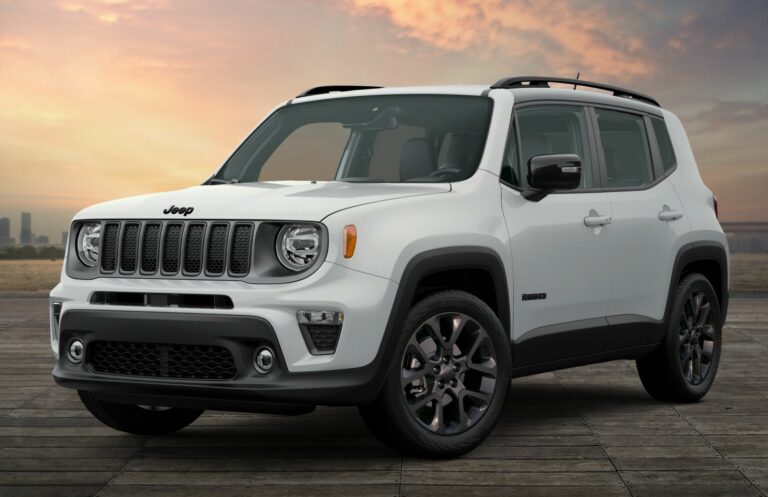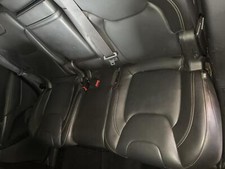1997 Jeep Wrangler 2 Door: The Genesis of a Modern Icon
1997 Jeep Wrangler 2 Door: The Genesis of a Modern Icon jeeps.truckstrend.com
The year 1997 marked a pivotal moment in the storied history of the Jeep Wrangler. After a decade of the square-headlight YJ, Jeep introduced the world to the TJ generation, a vehicle that masterfully blended the raw, adventurous spirit of its predecessors with significant advancements in comfort and drivability. The 1997 Jeep Wrangler 2 Door, as the inaugural model of this new era, quickly cemented its place as a beloved icon among off-road enthusiasts and casual drivers alike. It represented a return to the classic round headlights, a nod to its heritage, while ushering in a revolutionary coil-spring suspension system that transformed its on-road manners without sacrificing its legendary off-road prowess. For many, the ’97 TJ is the quintessential Wrangler, offering the perfect balance of rugged capability and a surprisingly refined (for a Jeep) driving experience, making it a highly sought-after vehicle even today.
The Dawn of a New Era: Understanding the 1997 TJ Wrangler
1997 Jeep Wrangler 2 Door: The Genesis of a Modern Icon
The most significant change distinguishing the 1997 TJ from its YJ predecessor was the groundbreaking shift from leaf-spring to coil-spring suspension at all four corners. This single engineering decision dramatically improved ride quality, articulation, and overall handling, making the Wrangler far more comfortable for daily driving without compromising its formidable off-road capabilities. Beyond the suspension, the TJ brought back the iconic round headlights, a feature passionately missed by many purists. The interior also received a much-needed overhaul, offering improved ergonomics, more modern controls, and better quality materials. While still undeniably a utilitarian vehicle, the 1997 TJ was a clear step forward in terms of refinement and user experience, setting the stage for future Wrangler generations.
Engine and Drivetrain Options: The Heart of the Beast
The 1997 Jeep Wrangler offered two robust and well-proven engine choices, both inherited from previous Jeep models, ensuring reliability and a wealth of aftermarket support:
- 2.5L AMC I4 (Inline-4 Cylinder): This standard engine, producing around 120 horsepower and 140 lb-ft of torque, was adequate for light-duty use and trails. It’s known for its simplicity and durability, though it can feel underpowered, especially with larger tires or on the highway. It was typically paired with a 5-speed manual transmission.
- 4.0L AMC I6 (Inline-6 Cylinder): The undisputed king of TJ engines, this optional powerhouse delivered a stout 181 horsepower and 222 lb-ft of torque. Renowned for its bulletproof reliability, ample low-end torque, and smooth operation, the 4.0L is the preferred choice for most enthusiasts due to its superior performance on and off-road. It could be optioned with either the 5-speed manual or a 3-speed automatic transmission.
Both engines were mated to Jeep’s legendary Command-Trac NV231 part-time 4WD transfer case, offering 2H, 4H, and 4L settings for various traction needs. Axle configurations typically included a Dana 30 in the front and a Dana 35 in the rear, though some Sport and Sahara models could be found with the more robust Dana 44 rear axle as an option, a significant plus for serious off-roaders.

Trim Levels and Features: Customizing Your Wrangler
For 1997, the 2-door Wrangler was available in a few distinct trim levels, each offering a different balance of features and amenities:
- SE: This was the base model, typically equipped with the 2.5L engine, manual transmission, and basic features like a soft top, manual windows, and steel wheels. It was the most affordable entry point into the Wrangler family, perfect for those seeking a no-frills off-road machine.
- Sport: A step up from the SE, the Sport trim often included the desirable 4.0L engine as standard or an available option. It usually featured alloy wheels, more comfortable cloth seats, and provisions for air conditioning, offering a better blend of performance and creature comforts.
- Sahara: The top-tier trim, the Sahara provided a more upscale experience. It boasted unique styling cues like body-color fender flares, premium cloth seats, specific alloy wheels, fog lamps, and often came standard with the 4.0L engine, cruise control, and air conditioning. It aimed to offer a more comfortable and visually distinct package for those who wanted a bit more luxury from their adventure vehicle.
Optional accessories like full steel doors, a hardtop, automatic transmission, and various audio system upgrades were available across the trims, allowing buyers to customize their Wrangler to their specific needs.
On-Road Comfort and Off-Road Prowess: The Best of Both Worlds?
The 1997 TJ Wrangler truly represented a significant leap in on-road manners compared to its YJ predecessor. The coil-spring suspension absorbed bumps more effectively, leading to a smoother, less jarring ride. While still a short-wheelbase, solid-axle vehicle that isn’t mistaken for a luxury sedan, it was a vast improvement. Road noise, especially with the soft top, was still prominent, and steering could feel a bit vague at higher speeds. However, for a vehicle designed for rugged terrain, its highway performance was remarkably competent.
Off-road, the ’97 TJ truly shined. Its compact size, excellent approach and departure angles, robust 4WD system, and ample ground clearance made it a formidable rock crawler and trail conqueror. The improved articulation from the coil springs allowed wheels to stay in contact with the ground over uneven terrain, enhancing traction. Whether navigating tight forest trails or scaling rocky ascents, the 1997 Wrangler demonstrated why it remains a top choice for serious off-road enthusiasts.
Buying and Owning a 1997 Jeep Wrangler Today: Important Considerations
Purchasing a 1997 Jeep Wrangler today requires careful consideration due to its age and the typical life of an off-road vehicle.
What to Look For:
- Rust: This is the primary enemy of any TJ. Inspect the frame thoroughly, especially around the control arm mounts, skid plates, and suspension mounts. Check the floor pans, body mounts, and rocker panels. Surface rust is common, but advanced rot is a deal-breaker.
- Maintenance History: Look for records of regular oil changes, coolant flushes, and transmission/transfer case fluid services. The 4.0L is robust, but proper maintenance extends its life.
- Fluid Leaks: Check for oil leaks (especially from the rear main seal or valve cover on the 4.0L), coolant leaks, and transmission/transfer case fluid leaks.
- Suspension Components: Inspect control arm bushings, ball joints, tie rod ends, and shock absorbers for wear or damage, particularly if the vehicle has been lifted.
- Modifications: Many TJs are modified. Assess the quality of modifications. Poorly installed lifts, oversized tires, or custom fabrication can lead to headaches. Ensure modifications are well-done and documented.
- Soft Top/Hardtop Condition: Check for rips, tears, clear window clarity, and proper sealing. Hardtops should be free of cracks and have intact seals.
Common Issues:
- Exhaust Manifold Cracks: Very common on the 4.0L engine, leading to ticking noises.
- Oil Leaks: Valve cover gasket, oil pan gasket, and rear main seal are common culprits.
- Blend Door Issues: Problems with the HVAC blend door can prevent proper temperature control.
- Soft Top Wear: Zippers fail, windows yellow, and fabric degrades over time.
- Sagging Springs/Worn Shocks: Especially on older vehicles or those that have seen heavy off-road use.
Maintenance Tips:
- Rust Prevention: Regularly wash the undercarriage, especially after off-roading or driving in salty conditions. Consider undercoating or rust-proofing.
- Fluid Checks: Regularly check all fluid levels (oil, coolant, power steering, brake, transmission, transfer case, differentials).
- Grease Points: Lubricate universal joints and other chassis components regularly.
- Tire Rotation and Pressure: Essential for even tire wear and proper handling.
- Cooling System: Keep the cooling system (radiator, hoses, water pump) in good shape, especially for the 4.0L.
The Enduring Appeal: Why the ’97 TJ Remains a Classic
The 1997 Jeep Wrangler holds a special place in the hearts of many enthusiasts for several compelling reasons. It successfully brought back the classic aesthetic with its round headlights while fundamentally improving the driving experience with the coil-spring suspension. Its 4.0L engine is legendary for its reliability and torque, making it a truly capable off-road machine. The immense aftermarket support means parts are readily available, and customization possibilities are endless. Beyond its mechanical attributes, the ’97 TJ embodies a spirit of freedom and adventure that is uniquely Jeep, fostering a strong community of owners who appreciate its rugged simplicity and timeless design.
Pricing for the 1997 Jeep Wrangler 2 Door
The market value of a 1997 Jeep Wrangler can fluctuate significantly based on condition, mileage, engine type, trim level, modifications, and regional demand. The table below provides a general range, but a pre-purchase inspection is always recommended.
| Condition Category | Estimated Price Range (USD) | Key Factors Influencing Price |
|---|---|---|
| Fair/Poor Condition | $4,000 – $8,000 | Significant rust, high mileage, mechanical issues, extensive wear. |
| Good Condition | $8,000 – $14,000 | Minor rust, average mileage (100k-180k), well-maintained, some mods. |
| Excellent/Collector | $14,000 – $25,000+ | Low mileage (<100k), minimal to no rust, original condition or tasteful, high-quality modifications, 4.0L engine, Sahara/Sport trims. |
Additional Factors Affecting Price:
- Engine: 4.0L models consistently command higher prices than 2.5L models.
- Transmission: Manual transmissions are often preferred by enthusiasts, but automatics can be desirable for daily driving.
- Hardtop vs. Soft Top: Vehicles with both a hardtop and a soft top are more valuable.
- Axles: The presence of a Dana 44 rear axle (optional on some Sport/Sahara models) increases value.
- Modifications: Well-executed, high-quality modifications (e.g., reputable lift kits, armor) can increase value, while poorly done or extreme modifications can decrease it.
Frequently Asked Questions (FAQ) about the 1997 Jeep Wrangler 2 Door
Q1: Is the 1997 Jeep Wrangler reliable?
A1: Yes, especially models equipped with the 4.0L inline-six engine, which is known for its legendary durability. Like any older vehicle, consistent maintenance is key to its reliability.
Q2: Which engine is better, the 2.5L or the 4.0L?
A2: For most buyers, the 4.0L inline-six is significantly better. It offers superior horsepower and torque, making it more capable on the highway, for towing, and especially for off-roading. The 2.5L is adequate for lighter use but can feel underpowered.
Q3: What are the most common problems with the ’97 TJ?
A3: The most prevalent issues include frame rust, exhaust manifold cracks (4.0L), oil leaks (particularly from the rear main seal), and issues with the HVAC blend door. Soft tops also tend to wear out over time.
Q4: Can I daily drive a 1997 Wrangler?
A4: Yes, many people daily drive their 1997 Wranglers. The coil-spring suspension significantly improved ride comfort over previous generations. However, be prepared for more road noise (especially with a soft top), less refined handling than modern SUVs, and potentially higher fuel consumption.
Q5: Are parts still available for the 1997 Wrangler?
A5: Absolutely. Due to the TJ’s popularity and long production run (1997-2006), both OEM and aftermarket parts are widely available. This includes everything from routine maintenance items to specialized off-road components.
Q6: How much does a 1997 Wrangler typically cost?
A6: As detailed in the pricing table above, prices vary widely. You can expect to pay anywhere from $4,000 for a project vehicle to over $25,000 for a low-mileage, pristine, or highly modified example.
Q7: Is the 1997 Wrangler good for off-roading?
A7: The 1997 Wrangler TJ is exceptionally good for off-roading. Its compact size, short wheelbase, solid axles, excellent articulation from the coil springs, and robust 4WD system make it one of the most capable stock off-road vehicles ever produced. It’s a favorite platform for serious trail enthusiasts.
In conclusion, the 1997 Jeep Wrangler 2 Door stands as a landmark vehicle in the brand’s history. It successfully merged the iconic Jeep heritage with modern engineering, delivering a vehicle that was both more comfortable for daily use and even more capable on the trails. Its rugged dependability, timeless design, and vast aftermarket support ensure its continued popularity. For those seeking an authentic, engaging, and highly capable off-road experience that can still serve as a daily driver, the 1997 TJ Wrangler remains an outstanding choice and a true testament to Jeep’s enduring legacy of adventure.




